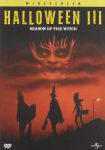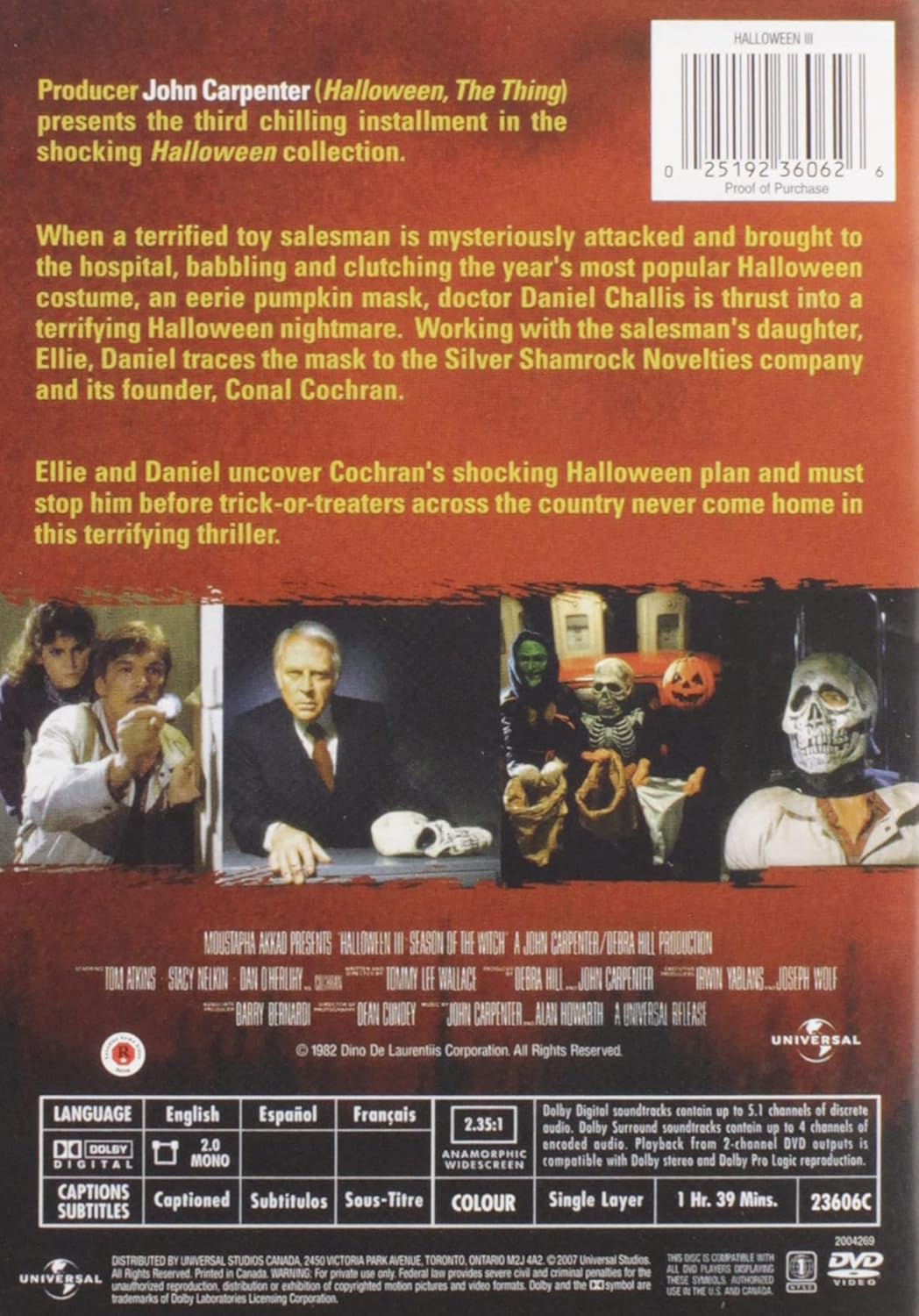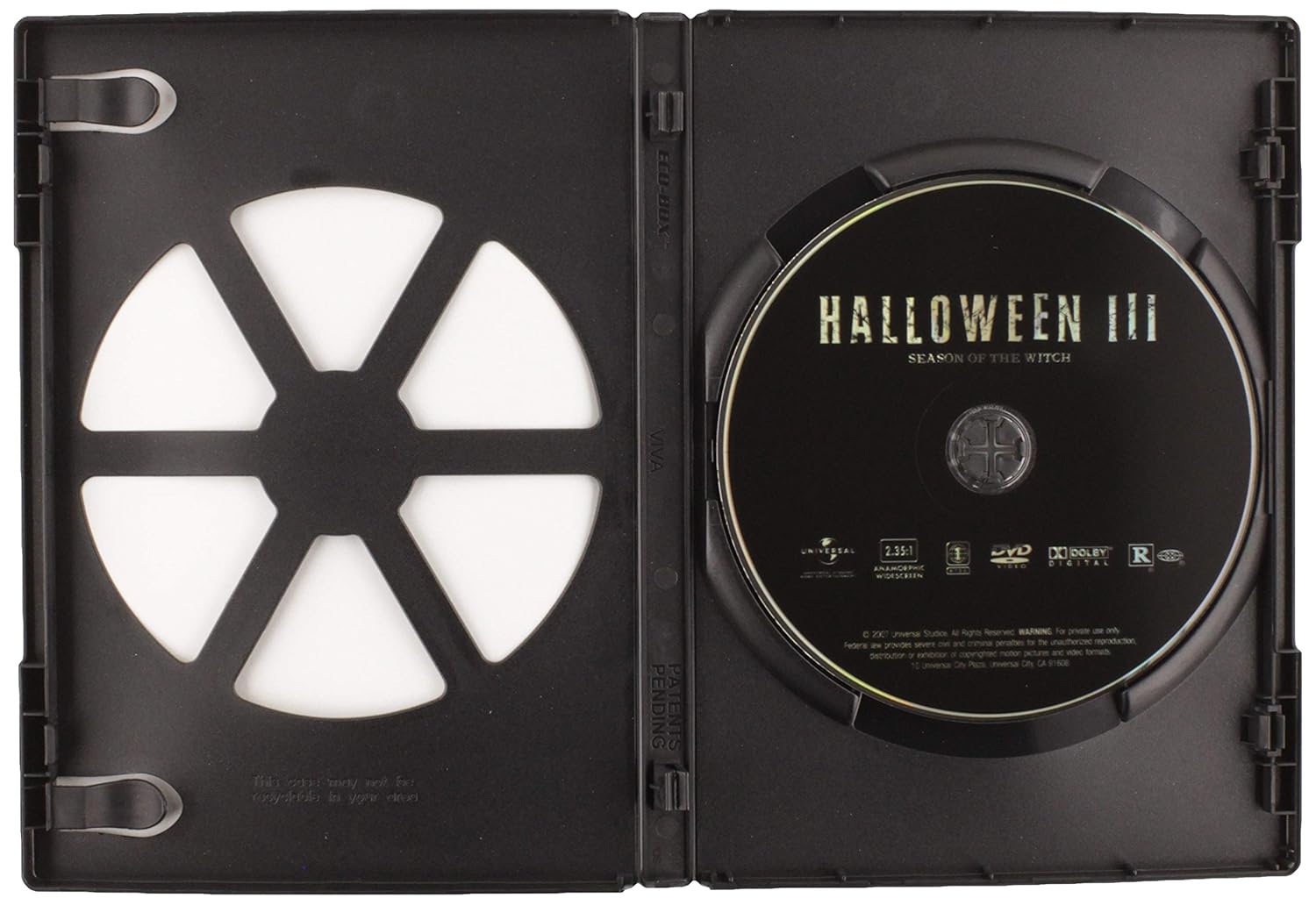
Halloween III: Season Of The Witch Review Best Halloween Movies – Oemiu
Halloween III: Season Of The Witch – A Cult Classic Re-Examined
Many consider it a black sheep, an outcast among its brethren, but Halloween III: Season of the Witch stands as a fascinating, if controversial, entry in the legendary horror franchise. Released in 1982, this film daringly departs from the Michael Myers storyline, instead offering a standalone tale steeped in pagan mythology, corporate conspiracy, and the chilling potential of mass-produced evil. While initially met with harsh criticism from fans expecting more of the iconic masked killer, “Season of the Witch” has gradually garnered a cult following, appreciated for its unique atmosphere, unsettling themes, and commitment to a different kind of horror. This isn’t your typical slasher; it’s a descent into a nightmare fueled by ancient rituals and the exploitation of innocent children. Its placement within the broader context of best Halloween movies is still debated, yet its distinctiveness cannot be denied. Let’s delve into the reasons why “Halloween III” deserves a closer look, examining its strengths, weaknesses, and enduring legacy.
The Night the Shape Was Missing: A Bold Gamble
Following the massive success of John Carpenter’s original “Halloween” and the respectable sequel, “Halloween II,” producers John Carpenter and Debra Hill made a bold decision: transform the Halloween film series into an anthology. Each installment would tell a self-contained horror story loosely connected by the holiday itself. The idea was ambitious, aiming to explore the diverse and often unsettling aspects of Halloween traditions beyond the singular terror of Michael Myers. “Season of the Witch” was the inaugural attempt at this anthology format. The story centers around Dr. Daniel Challis (Tom Atkins), a doctor investigating the bizarre murder of a patient who was clutching a Silver Shamrock Halloween mask. His investigation leads him to the seemingly idyllic town of Santa Mira, California, home to the Silver Shamrock Novelties company, led by the enigmatic Conal Cochran (Dan O’Herlihy). As Challis and the victim’s daughter, Ellie Grimbridge (Stacey Nelkin), dig deeper, they uncover a sinister plot involving ancient Celtic rituals, technologically advanced androids, and a plan to sacrifice children on Halloween night using masks embedded with fragments of Stonehenge.
The narrative is a far cry from the stalk-and-slash formula that defined the first two films. It trades in suspense and gore for a creeping sense of unease, a feeling that something is profoundly wrong beneath the surface of this seemingly normal town. The film successfully evokes a sense of isolation and dread, as Challis and Ellie find themselves increasingly surrounded by androids and Cochran’s loyal followers. The absence of Michael Myers was undoubtedly a shock to audiences at the time, and it’s a significant reason why the film was initially rejected. However, viewed through a modern lens, this departure allows “Season of the Witch” to stand on its own merits, exploring themes of corporate greed, technological manipulation, and the dark side of tradition in a way that the Myers saga never could. The film’s daring deviation firmly places it in a distinct category when discussing the best Halloween movies.
Silver Shamrock: Jingles, Masks, and Mayan Sacrifice
The core of “Halloween III’s” horror lies in its unique villain: Conal Cochran and his Silver Shamrock Novelties company. Cochran is not a mindless killing machine like Michael Myers; he’s a calculating, charismatic businessman driven by a twisted sense of purpose. He seeks to resurrect an ancient Celtic festival, Samhain, by sacrificing children wearing his Silver Shamrock masks on Halloween night. The masks, embedded with pieces of Stonehenge, will trigger a deadly reaction when activated by a signal broadcast through television commercials, unleashing hordes of snakes and insects to kill the children and anyone nearby. This element of mass-produced evil is a particularly disturbing aspect of the film. It suggests that even the most seemingly innocuous products – Halloween masks designed for children – can be instruments of unimaginable horror. The insidious jingle, “Eight more days ’til Halloween, Halloween, Halloween. Eight more days ’til Halloween. Silver Shamrock,” becomes a symbol of this creeping dread, relentlessly playing on televisions and radios, a constant reminder of the impending doom.
The film’s visual style contributes significantly to its unsettling atmosphere. The cinematography is often dark and claustrophobic, emphasizing the feeling of being trapped in Santa Mira. The use of vibrant colors, particularly the orange of the Halloween masks and decorations, creates a jarring contrast with the underlying darkness. The special effects, while dated by today’s standards, are still effective in conveying the gruesome nature of Cochran’s plan. The scenes of children’s faces melting and swarming with insects are genuinely disturbing and contribute to the film’s overall sense of unease.
The film also subtly critiques the commercialization of Halloween. Silver Shamrock Novelties represents the relentless pursuit of profit, even at the expense of human lives. Cochran’s plan is driven by a desire to control and manipulate the masses, using the power of advertising and technology to achieve his twisted goals. This commentary on consumerism and corporate greed adds another layer of depth to the film’s horror. The film’s unique approach, though initially controversial, warrants its inclusion in any conversation about the best Halloween movies.
| Feature | Michael Myers Films | Halloween III: Season of the Witch |
|---|---|---|
| Main Antagonist | Michael Myers | Conal Cochran |
| Type of Horror | Slasher | Supernatural/Technological Horror |
| Setting | Haddonfield, Illinois | Santa Mira, California |
| Theme | Pure Evil, Stalking | Corporate Greed, Pagan Rituals |
| Audience Reception (Initial) | Generally Positive | Negative |
| Audience Reception (Later) | Remains Positive | Cult Following |
Acting, Directing, and the Unsettling Score
“Halloween III” benefits from solid performances, particularly from Tom Atkins as Dr. Challis and Dan O’Herlihy as Conal Cochran. Atkins brings a world-weariness and determination to his role, portraying Challis as a flawed but ultimately heroic figure. O’Herlihy is chillingly effective as Cochran, conveying a sense of both menace and charm. He perfectly captures the character’s twisted ideology and unwavering commitment to his diabolical plan. The supporting cast also delivers commendable performances, adding to the film’s overall sense of realism.
The film is directed by Tommy Lee Wallace, who also co-wrote the screenplay with John Carpenter and Debra Hill. Wallace does an excellent job of creating a suspenseful and unsettling atmosphere. He utilizes effective camera angles, lighting, and editing techniques to heighten the sense of dread and unease. The pacing of the film is deliberate, allowing the story to unfold gradually and build tension. Wallace skillfully balances the elements of suspense, horror, and science fiction, creating a unique and memorable cinematic experience.
Perhaps one of the film’s most underappreciated aspects is its score, composed by John Carpenter and Alan Howarth. The score is distinctly different from Carpenter’s iconic “Halloween” theme, but it’s equally effective in creating a sense of dread and unease. The use of synthesizers and electronic music adds to the film’s science fiction elements, while the haunting melodies evoke the ancient Celtic rituals that are central to the story. The score perfectly complements the film’s visuals and atmosphere, enhancing its overall impact. The soundtrack’s sinister undertones greatly contribute to the film’s unique position amongst the best Halloween movies.
Why “Season of the Witch” Deserves Its Cult Status
Despite its initial negative reception, “Halloween III: Season of the Witch” has gradually gained a devoted cult following. There are several reasons why this film has resonated with audiences over time. First, its originality and willingness to break from the established formula are commendable. In a genre often dominated by sequels and remakes, “Season of the Witch” dares to be different, offering a unique and unsettling vision of Halloween. Second, the film’s themes of corporate greed, technological manipulation, and the dark side of tradition are increasingly relevant in today’s society. The idea that even seemingly innocuous products can be used for nefarious purposes is a chilling reminder of the potential for exploitation and manipulation in the modern world.
Third, the film’s unsettling atmosphere and memorable visuals have made it a cult classic. The image of the Silver Shamrock masks, the relentless jingle, and the gruesome special effects have all become iconic elements of the film. Fourth, the film’s reevaluation is partly due to the fact that viewers now come to it without the expectation of seeing Michael Myers. They are more open to appreciating the film on its own merits, as a standalone horror story with its own unique strengths.
Finally, “Halloween III” offers a refreshing alternative to the slasher films that dominated the horror genre in the 1980s. It’s a more cerebral and atmospheric horror film that relies on suspense and unease rather than cheap scares and gratuitous violence. While it may not be for everyone, “Season of the Witch” is a thought-provoking and unsettling film that deserves its place among the best Halloween movies, even if it’s a controversial one. Ultimately, its distinctiveness is what sets it apart and makes it a film worth revisiting and re-evaluating. Exploring the complete spectrum of best Halloween movies requires a deep dive into films like “Season of the Witch” that challenge conventional norms.
| Aspect | Pros | Cons |
|---|---|---|
| Originality | Unique storyline, departs from slasher formula | Disconnect from previous “Halloween” films, lack of Michael Myers |
| Themes | Relevant commentary on corporate greed and technology | Potentially confusing or unsettling for some viewers |
| Atmosphere | Suspenseful and unsettling atmosphere | Pacing might be slow for some |
| Acting | Strong performances from Tom Atkins and Dan O’Herlihy | Some character development could be improved |
| Score | Effective and memorable soundtrack | Different style from the original “Halloween” theme |
Frequently Asked Questions (FAQ)
Why is “Halloween III” so different from the other films in the series?
The reason “Halloween III: Season of the Witch” is so distinct from the rest of the series stems from the original vision for the franchise. John Carpenter and Debra Hill intended for the “Halloween” series to become an anthology, with each film telling a different, self-contained horror story centered around the Halloween holiday. “Season of the Witch” was meant to be the first installment in this anthology, but the negative reaction to the absence of Michael Myers led to the abandonment of this concept and a return to the slasher formula in subsequent sequels. The difference, therefore, isn’t a mistake or a misstep, but a deliberate artistic choice to explore the broader potential of Halloween as a setting for horror.
Is “Halloween III” considered a good movie by critics and audiences today?
Initially, “Halloween III” was met with largely negative reviews and disappointment from audiences who expected another Michael Myers slasher film. However, over time, the film has undergone a significant reevaluation. While it’s still not universally loved, it has garnered a strong cult following and is often praised for its originality, unsettling atmosphere, and social commentary. Many critics and audiences now appreciate the film’s willingness to break from convention and explore different themes within the horror genre. Its unique identity, while divisive, is now seen as a strength by many who consider it among the more interesting and thought-provoking entries related to best Halloween movies.
What is the significance of the Silver Shamrock masks in the film?
The Silver Shamrock masks are central to the plot of “Halloween III” and represent the film’s themes of corporate greed and the manipulation of innocence. The masks, designed for children to wear on Halloween, are embedded with pieces of Stonehenge that, when activated by a signal broadcast through television commercials, will cause the wearers to suffer a gruesome death. This symbolizes how even seemingly innocuous products can be used for nefarious purposes, and how corporations can exploit and endanger consumers for profit. The masks are a powerful visual representation of the film’s message about the dangers of unchecked commercialism.
What are the Celtic rituals that Conal Cochran is trying to revive?
Conal Cochran’s plan in “Halloween III” is rooted in the ancient Celtic festival of Samhain, which is considered the origin of modern-day Halloween. He seeks to revive the darker, more primal aspects of Samhain, which involved rituals and sacrifices intended to appease pagan gods and ensure a successful harvest. Cochran believes that by sacrificing children on Halloween night, he can restore the power of these ancient rituals and unleash chaos and destruction upon the world. His actions are a twisted and corrupted interpretation of Celtic traditions, reflecting the film’s theme of the dark side of tradition.
How does “Halloween III” comment on the commercialization of Halloween?
“Halloween III” offers a scathing critique of the commercialization of Halloween through the character of Conal Cochran and his Silver Shamrock Novelties company. Cochran represents the relentless pursuit of profit, even at the expense of human lives. His plan to sacrifice children wearing his masks is driven by a desire to control and manipulate the masses, using the power of advertising and technology to achieve his twisted goals. The film suggests that the focus on consumerism and profit can strip Halloween of its original meaning and turn it into a hollow and dangerous spectacle. This commentary is particularly relevant today, as Halloween has become increasingly commercialized in recent years.
Is “Halloween III” scary?
The scariness of “Halloween III” is subjective and depends on the viewer’s preferences. It is not a traditional slasher film with jump scares and gratuitous violence. Instead, it relies on a more atmospheric and suspenseful approach to horror, creating a creeping sense of unease and dread. The film’s unsettling visuals, particularly the scenes of children’s faces melting and swarming with insects, can be disturbing for some viewers. The themes of corporate greed, technological manipulation, and the dark side of tradition also contribute to the film’s overall sense of unease. While it may not be as overtly scary as some other horror films, “Halloween III” offers a more subtle and thought-provoking form of terror.
Does “Halloween III” have any connections to the other films in the series?
Are there any subtle Easter eggs?
While “Halloween III” is a standalone story that does not directly feature Michael Myers, there are a few subtle connections to the other films in the series. For example, a television commercial for “Halloween” (1978) briefly appears on a television screen. This Easter egg serves as a nod to the original film and acknowledges its existence within the world of “Season of the Witch.” Beyond this subtle reference, “Halloween III” exists in its own separate continuity, making it a unique and distinct entry in the franchise. Despite its separation from the Michael Myers narrative, its inclusion in discussions about best Halloween movies often sparks lively debates.









